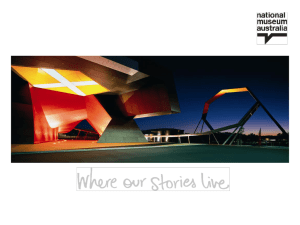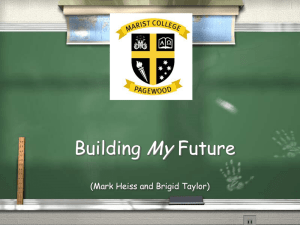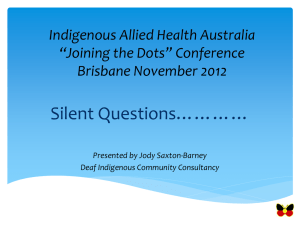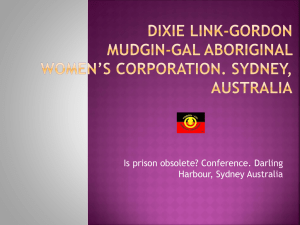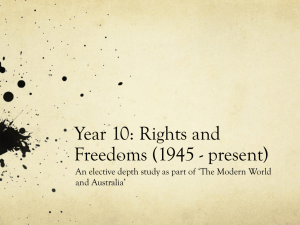File
advertisement
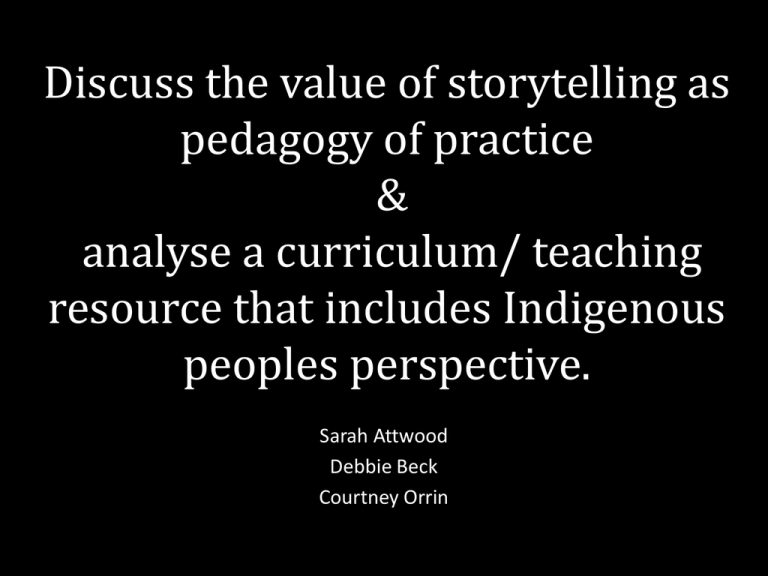
Discuss the value of storytelling as pedagogy of practice & analyse a curriculum/ teaching resource that includes Indigenous peoples perspective. Sarah Attwood Debbie Beck Courtney Orrin We would like to acknowledge this land that we meet on today is the traditional lands for Kaurna people and that we respect their spiritual relationship with the country. We also acknowledge the Kaurna people as the custodians of the Adelaide region and that their cultural and heritage beliefs are still as important to the living Kaurna people today. How we learn - culture way The Dreaming The Dreamtime "was", The Dreaming "is". Critical Pedagogy • “Critical Pedagogy must address the challenge of providing students with the competencies they need to cultivate the capacity for critical judgment, to thoughtfully connect politics to social responsibility and expand their own sense of agency in order to curb the excesses of dominant power, to revitalize a sense of public commitment, and to expand democratic relations. Animated by a spirit of critique and possibility … (p.3) Politics to Social responsibility Politics Politics Curbing Dominant Power Indigenous harmony Australian division Public Commitment Public Commitment Public Commitment Storytelling • How can story telling as pedagogy helps Indigenous students? Applying Curriculum to Practice ‘8 Ways of Learning’; Pedagogical Framework & How do we incorporate our knowledge and adapt it for classroom practices? Acara: Cross-curriculum priorities There are three cross curriculum priorities in the Australian Curriculum: • Aboriginal and Torres Strait Islander histories and cultures • Asia and Australia’s engagement with Asia • Sustainability. 8 Ways Pedagogical Framework. (starting top left with story sharing, then working anti-clockwise). Aboriginal and Torres Strait Islander histories and cultures Story Sharing the importance of yarning Aboriginal culture has long employed narrative pedagogy as a way of sharing knowledge. Learning Maps Mapping out the direction of learning in a classroom creates a reference point for students to revisit past learning and see where they are going next. Non-Verbal ‘Kinaesthetic, hands-on learning is a characteristic element of Aboriginal pedagogy ‘(Craven, 1999). Symbols and Images ‘Symbols and images have always been central to cultural expression and learning’ (Yunkaporta, 2009). Land Links Concrete local examples have more meaning for students and at the same time demonstrate the diversity of experiences of Aboriginal people and communities. http://youtu.be/lZR-XKm1jMM Non-Linear Methods • This way of learning acknowledges that Indigenous and non- Indigenous people have different ways of approaching and structuring knowledge. ‘Indigenous non-linear pedagogy involves repetition, returning to concepts for deeper understanding’ (Yunkaporta, 2007). Deconstruct/Reconstruct ‘The holistic nature of Aboriginal culture suggests that global teaching strategies are likely to be more effective for Aboriginal students – looking at the big picture before getting down to the details’ (Harrison, 2008 & Yunkaporta, 2009). Community Links Involving local Elders and other community members in development of curriculum ensures that the content is culturally relevant and meaningful for the local community (Craven, 1999). ACARA: Implications for teaching, assessment and reporting • ‘Students’ interest in and enjoyment of history is enhanced through a range of different approaches such as the use of artefacts, museums, historical sites, hands-on activities and archives’. • ‘Historical narrative is used so that students experience the ‘story’ in history, and this can be extended to investigations of cause and consequence, historical significance and contestability’. • ‘Connections are made where appropriate between past and present events and circumstances to make learning more meaningful for students and to help students make sense of key ideas’. Acara: Aboriginal and Torres Strait Islander histories and cultures: Code Organising ideas: Country/Place • OI.1 Australia has two distinct Indigenous groups, Aboriginal Peoples and Torres Strait Islander Peoples. • OI.2 Aboriginal and Torres Strait Islander communities maintain a special connection to and responsibility for Country/Place throughout all of Australia. • OI.3 Aboriginal and Torres Strait Islander Peoples have unique belief systems and are spiritually connected to the land, sea, sky and waterways. Acara: Culture • OI.4 Aboriginal and Torres Strait Islander societies have many Language Groups. • OI.5 Aboriginal and Torres Strait Islander Peoples’ ways of life are uniquely expressed through ways of being, knowing, thinking and doing. • OI.6 Aboriginal and Torres Strait Islander Peoples have lived in Australia for tens of thousands of years and experiences can be viewed through historical, social and political lenses. Acara: People • OI.7 The broader Aboriginal and Torres Strait Islander societies encompass a diversity of nations across Australia. • OI.8 Aboriginal and Torres Strait Islander Peoples have sophisticated family and kinship structures. • OI.9 Australia acknowledges the significant contributions of Aboriginal and Torres Strait Islander people locally and globally. Assessment of the Australian Curriculum takes place in different levels and for different purposes, including: • ongoing formative assessment within classrooms. • summative assessment • annual testing of Years 3, 5, 7 and 9 students’ • periodic sample testing 8 Ways of Learning Important note: 8ways should not be seen as a universal Indigenous knowledge framework; it is particular to communities from Western New South Wales. (8ways FAQ’s) What is Teaching for Resistance A Critical Pedagogy A Critical Pedagogy is first and foremost an approach to schooling – teaching, policy making, curriculum production –that emphasizes the political nature of education. Peter McLaren, 2003 “Life in Schools: An Introduction to Critical Pedagogy “ Raising Consciousness Orientation –to the concept of resistance Encounter –with issue in resistance Extension – extent of injustice and resistance to it Explanation – why unjust? Why resistance? Evaluation – of level of commitment to the issue Making Contact Searching – relevant resistance groups Preparing – preparing questions: contacting Meeting – meeting groups; discussing questions Evaluating – ideas and strategies of groups Taking Action Selecting and Planning – resistance action Implementing – resistance action Evaluating - resistance action/s Summary •In today’s presentation we have looked at how we, as teachers, can incorporate story telling into our classrooms. •Storytelling defines the Dreaming and the Dreamtime. •By telling stories we are providing a connection for Indigenous Students to their land, customs and laws. •When teaching Indigenous students in your class, be aware that the framework that you are using and ensure that it incorporates the importance of country/place, identity and people. •That an appropriate resistance model is followed when approaching education in a classroom –be inclusive. Tiddalik the Frog SA failing in indigenous education The Advertiser (Katrina Stokes .June 26, 2012. 10:00PM) SA is the worst performing state for indigenous education. (Source: The Courier-Mail) SOUTH Australia is the worst-performing state for indigenous education outcomes, a study has found. It reveals the state will not meet the Federal Government's target to "halve the gap" between indigenous and non-indigenous students in reading, writing and numeracy by 2018. Tiddalik the Frog • http://youtu.be/d9Hi__CbLQs Reference List 8ways - 8ways Whole-school e.g.. 2012. 8ways - 8ways Whole-school e.g.. [ONLINE] Available at: http://8ways.wikispaces.com/8ways+Whole-school+e.g.. [Accessed 26 August 2012]. Burgess, C. & Berwick, C. (2010). Aboriginal Peoples’ Perceptions and Beliefs about Quality Teaching. Retrieved 13 May, 2010, fromhttp://www.aare.edu.au/09pap/bur091065.pdf Craven, R. (1999). Teaching Aboriginal Studies. Crows Nest: Allen & Unwin Harbutt, K. (2008). The Power and the Passion. Education Times. • Harrison, N. (2008). Teaching and Learning in Indigenous Education. Melbourne: Oxford University Press. Shaw, P. (2009). Seven Seasons in Aurukun. Crows Nest, NSW: Allen & Unwin. Yunkaporta, T. (2009). 8 Aboriginal Ways of Learning. Retrieved 15 March, 2010, from http://8ways.wikispaces.com/ Twitter Closing the Gap@indigenous_gov Showcases Indigenous achievement and informs you about Australian Government policies. Australia http://www.indigenous.gov.au


